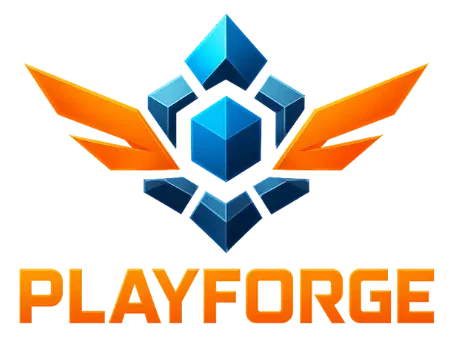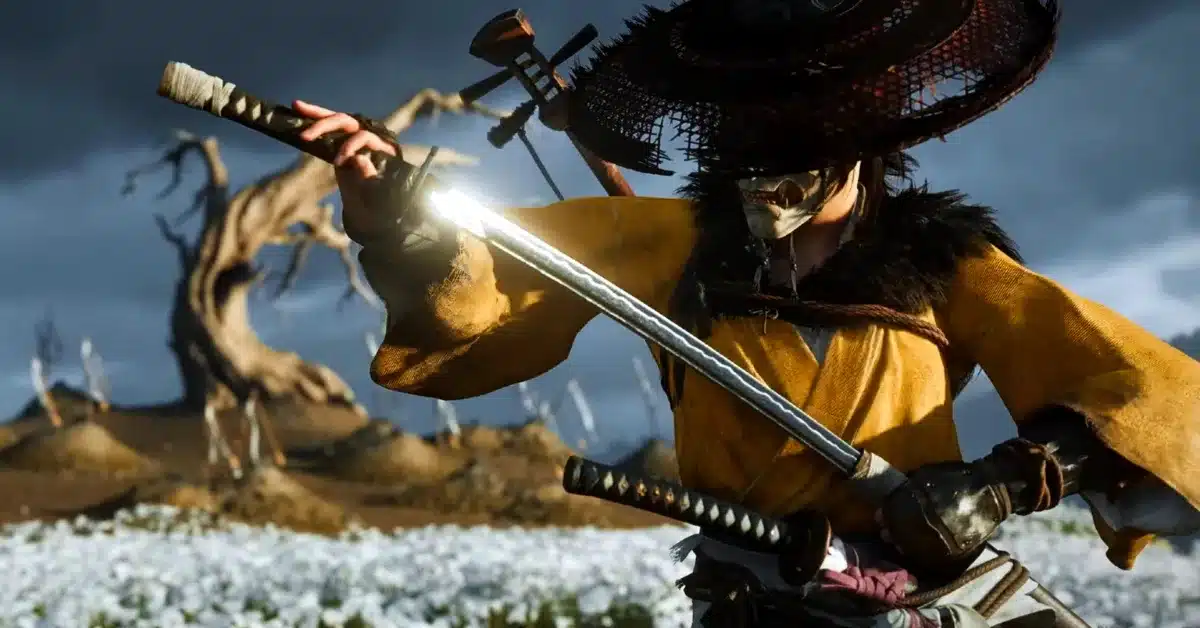Ghost of Yōtei has been my most anticipated game of the year. Its predecessor, Ghost of Tsushima, is probably my favorite game of all time, and so naturally, I couldn’t wait to play this one. Plus, all of the content that came out about it before it was released looked awesome.
And if that doesn’t tell you enough about how excited and hyped I was for this game, then you should know that I played it the moment it came out, even though I had a fever and felt like crap the whole time.
Right away, I was blown away by how stunning the snowy world of Yōtei looks. The swordplay is even sharper than before, and every moment feels like it belongs on the big screen. That said, was it all I wanted it to be? Read on to find out.
Last updated on:
Quick Facts About Ghost of Yōtei
| Developer/Publisher | Sucker Punch Productions / Sony Interactive Entertainment |
| Platform(s) | PlayStation 5 |
| Release Date | October 2, 2025 |
| Genre/Mode | Action-adventure (open world) / Single-player (with a free “Legends” multiplayer mode arriving 2026) |
| ESRB/PEGI | ESRB: M (17+) for Blood & Gore, Intense Violence, Partial Nudity, Use of Alcohol etc. PEGI: 18+ |
| Price/Free-to-Play Info | US$69.99; Deluxe editions with extra content are available; “Legends” multiplayer mode will be a free update for owners of the base game in 2026 |
Story & Setting in Ghost of Yōtei
Ghost of Yōtei is set in 1603, 329 years after Ghost of Tsushima. While both games share a samurai ethos and cinematic presentation, Yōtei is a spiritual sequel, not a direct continuation. The story follows Atsu, a rōnin seeking vengeance against the “Yōtei Six,” a group responsible for the massacre of her family and so the game’s story follows themes of grief, identity, and redemption.
Unlike Jin Sakai from Ghost of Tsushima, who grappled with the moral implications of his actions, Atsu fully embraces her role as an onryō, a vengeful spirit from Japanese folklore and this allows her to do what she needs to do without the constraints of samurai honor. And though I really loved the “samurai code” part of Tsushima, I liked this storyline as well.
The world-building in Yōtei is truly rich. I feel like it perfectly captures the stark beauty of northern Japan, with snow-covered mountains, dense forests, and traditional villages. You get to learn more about the Ainu culture and more. Plus, you get a dynamic weather system and a day-night cycle which makes all of it feel more realistic and immersive.
Other than the main storyline, you get a bunch of different side quests and stories. For example, you have the Sensei tales where you go into traditional Japanese martial arts, bounty hunts where you can track down criminals, mythic tales that are more about the supernatural elements and many optional quests to learn more about the inhabitants of Ezo.
In comparison to Ghost of Tsushima, Yōtei shifts from a grand, island-wide conflict to a more intimate, personal journey. While Tsushima focused on the Mongol invasion and the rise of the “Ghost,” Yōtei centers on a lone warrior’s quest for justice in a land shaped by its own myths and history.
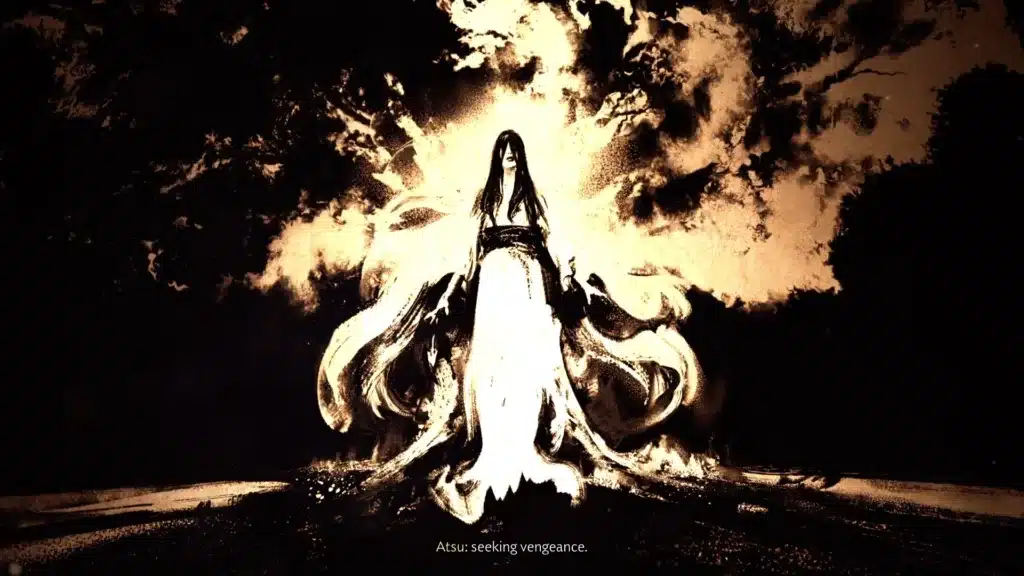
Who are the Yōtei Six?
The Yōtei Six are:
- Lord Saitō: The charismatic and ruthless leader.
- The Snake: A cunning strategist.
- The Oni: A brutal enforcer.
- The Kitsune: A deceptive illusionist.
- The Spider: A master of traps and poisons.
- The Dragon: A swift and deadly assassin.
Each member presents unique challenges, requiring Atsu to adapt her combat strategies and approach.
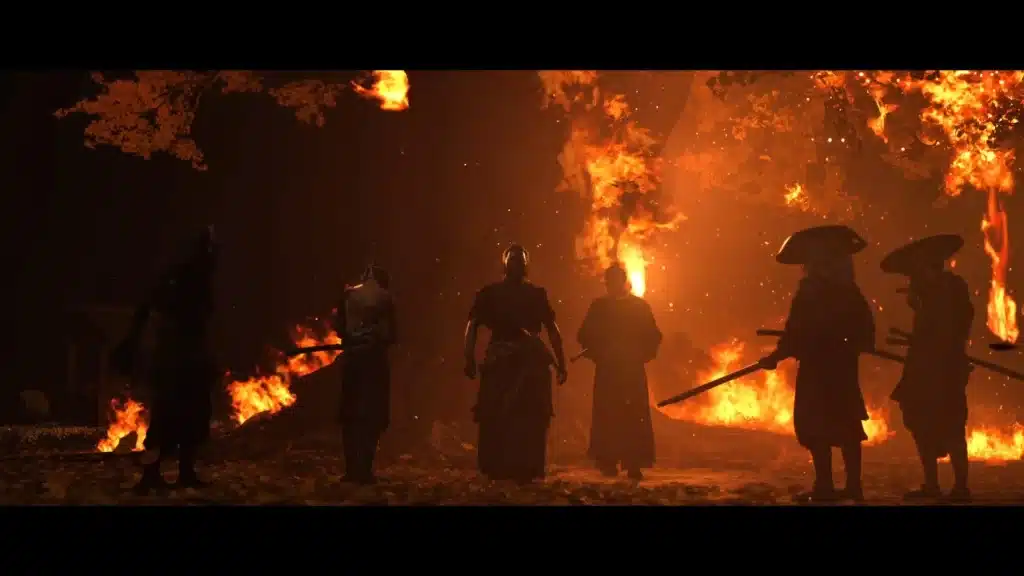
First 60 Minutes With Ghost of Yōtei
The first 60 minutes of Ghost of Yōtei can only be described as pure perfection. It starts with cool cinematics which lead to slow transition to the introductory gameplay. They’ve managed to create a perfect balance between those two. I’ve really gotten immersed into it. Swinging a sword, parrying, and blocking felt really impactful. And riding a horse, I’m telling you, nobody has done it better, not even RDD2. It does feel like I’m glazing but that’s just my genuine reaction to the first 60 minutes. I was amazed by everything. It was more than enough to prove that I made a right choice by getting the game and that developers did a great job with Ghost of Yōtei
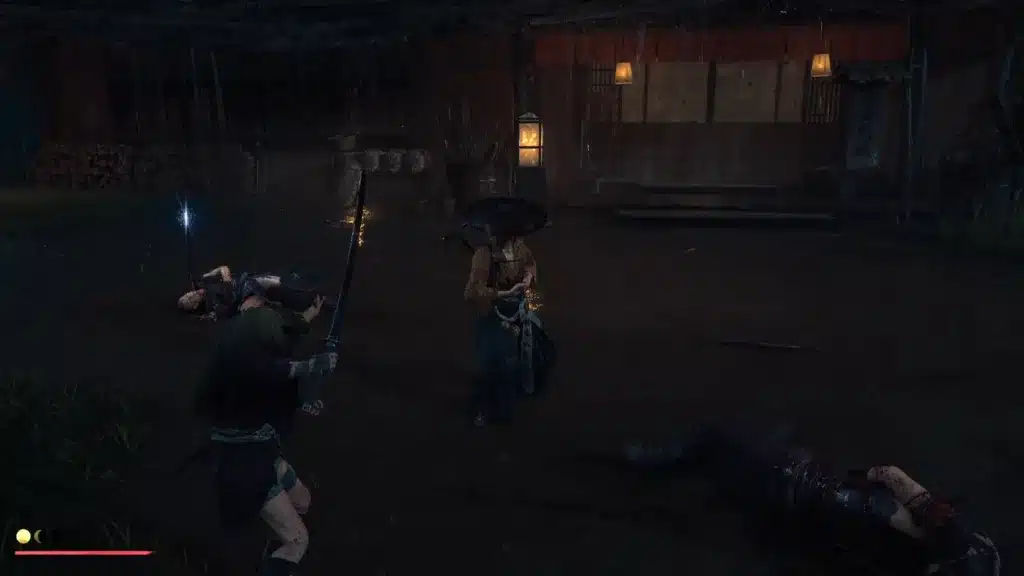
Ghost of Yōtei Gameplay & Mechanics
Ghost of Yōtei gameplay doesn’t have complicated mechanics or anything similar. Once you get the hang of the basics, it’s straightforward after that.
At heart, it’s an evolution of the tight swordplay of Ghost of Tsushima but rethought in a tactical and strategic way. Gone are the old “stance” categories; instead the game treats each weapon as its own role. And all of the weapons are distinct and worth learning — some excel at reach, others at quick ripostes or crowd control — and enemies will react to your choices. There’s also a proper weapon-management layer: enemies can drop weapons, you can pick them up, etc.
You also have the wolf, which is a delightful touch. You don’t have it glued to your hip, but instead you learn a “Song of the Wolf” and summon it when you need it (and you can).
Instead of a standard skill tree, Yōtei uses Altars of Reflection scattered throughout the world. Each altar lets you unlock techniques and upgrades that suit how you play. This makes it feel like it’s not just farming for XP, but more like a reward for exploring. And while that’s true, you can still customize it so you can play and build towards melee, survival, and/or “revenge” style (or some combo).
In general, what I can tell you is that the combat is crisp and improvisational, that the exploration is great (and beautiful), and that the game overall plays wonderfully.
Modes
Ghost of Yōtei offers three distinct cinematic modes, each inspired by renowned Japanese filmmakers:
- Kurosawa Mode: A black-and-white aesthetic with enhanced wind effects, paying homage to Akira Kurosawa’s films. This is just like in Ghost of Tsushima.
- Miike Mode: A closer, more intense combat view with added gore and mud, inspired by Takashi Miike’s style.
- Watanabe Mode: A relaxed experience with lo-fi beats replacing the standard soundtrack, inspired by Shinichirō Watanabe’s works.
This way, you can customize your experience so it’s what you want it to be.
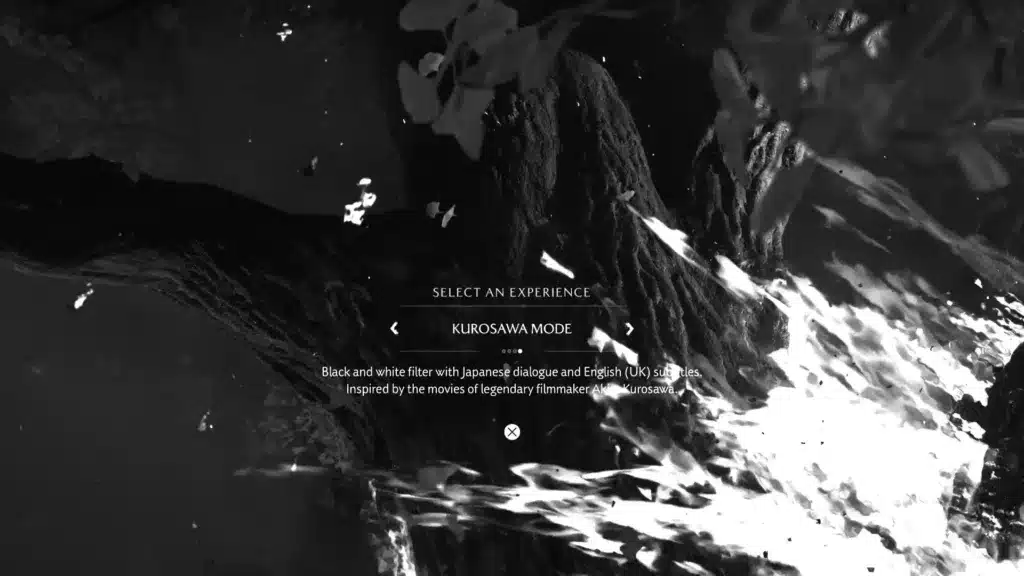
Graphics, Art & Sound
Ghost of Yōtei is, in a word, gorgeous. The visual style leans toward realistic but slightly stylized, with dramatic lighting and sweeping views that make exploration a joy. Everything looks like some big budget movie and it feels that way too. All of the effects — like sizzling food on a campfire or slicing through bamboo stalks, or blowing on embers to make a fire — are truly amazing.
On the performance side, the game runs beautifully on PlayStation 5 with surprisingly short load times for such a large open world. I never noticed any glitches or bugs and I had no issues the entire time I played it.
The sound design is top-notch: the crunch of snow underfoot, the swoosh of a katana, and distant wildlife all create an atmospheric world you can feel. And my favorite part, the music — it’s enchanting, and haunting, and it matches the game so perfectly. You might even want to add it to your playlist for later (I know I might).
As for voice acting and localization, the English version is excellent, with clear, expressive performances that make the characters feel alive. That said, fans of the Japanese dub will be happy to know it’s fully supported, keeping authenticity for those who prefer it.
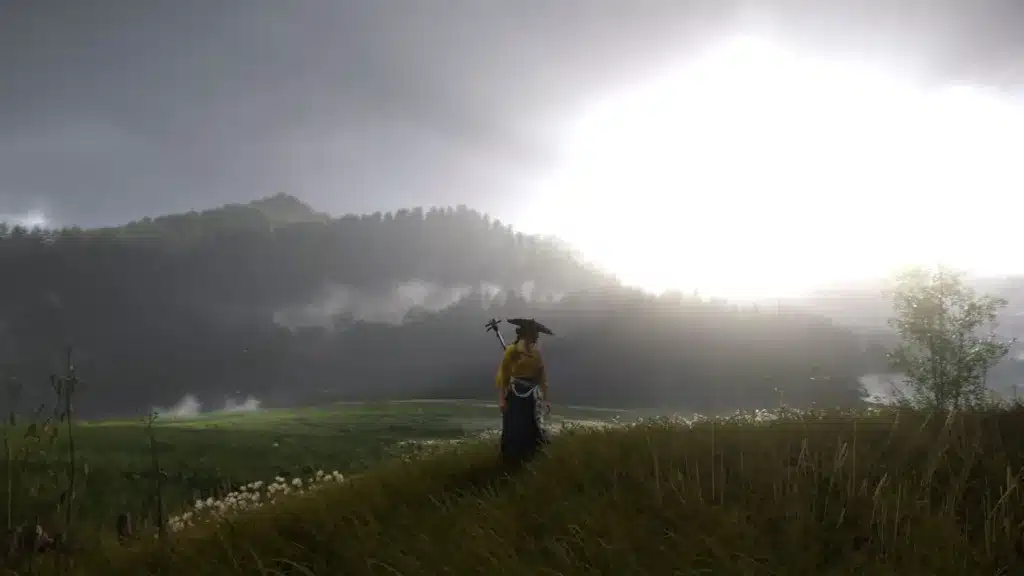
Ghost of Yōtei Pros & Cons
Ghost of Yōtei has a lot going for it: gorgeous snowy landscapes, cinematic combat, and an open world packed with things to explore. If you love action-adventure games, cinematic storytelling, or just wandering beautiful environments while perfecting your swordplay, this is an absolute treat. Honestly, I had to think really hard to find any cons to playing it, and even then they weren’t that serious.
Pros:
- Stunning, cinematic open-world visuals
- Fluid, satisfying sword combat
- Engaging story with memorable characters
- Multiple cinematic/visual modes for replay value
- Free Legends multiplayer update coming in 2026
Cons:
- Map-matching system feels unnecessary
- It’s a bit expensive (especially the Deluxe version that I got), but most big games these days cost about that much.
Games Like Ghost of Yōtei
If you’re looking for similar experiences, especially for less popular or hidden gems:
- Ghost of Tsushima – the obvious predecessor, perfect for fans of cinematic samurai action.
- Sekiro: Shadows Die Twice – more challenging combat-focused action with a rich world.
- Nioh 2 – deeper RPG mechanics and tough combat for hardcore players.
Final Verdict
Even though I was sick, played the whole game on easy mode, and even switched to the English dub just to make it easier to keep going, Ghost of Yōtei still completely swept me away. That alone should tell you how special this game is.
The only thing I didn’t really love was the little map-matching system—where you buy map pieces and then have to line them up with the larger world map. It felt more like busywork than a fun mechanic. But honestly, that’s such a tiny nitpick in a game that otherwise nailed everything I wanted from it.
So who would enjoy Ghost of Yōtei? Honestly, pretty much anyone who loves action-adventure games. Fans of Ghost of Tsushima will obviously feel right at home, but newcomers won’t have any trouble diving in either. You can play it casually, exploring the world and enjoying the scenery (and the occasional battle) or go hardcore — it fits both playstyles and everything in between.
As for value, it’s absolutely there. The story is long and rich, the world is packed with things to do, and I can already see myself replaying it just to experience the atmosphere again (maybe on a harder mode?). Plus, if you buy it, you get free access to the Legends multiplayer mode, which is awesome.
Final Rating: 10/10 🌟
FAQs
Your main story run will take you somewhere between 25–35 hours, depending on how much side content you dive into. If you go full completionist, exploring every corner and doing every quest, it could stretch closer to 40+.
Yes! Ghost of Yōtei: Legends is coming in 2026 as a free update for everyone who owns the base game. It will offer 2-player story missions and 4-player survival matches, with new enemies and content.
There are multiple difficulty levels (easy/traveler up to more punishing ones). You don’t need to go hardcore on your first playthrough — I played on easy and still had a full experience. If you want more challenge, bump it up on a second run.
Yep — Ghost of Yōtei brings back Kurosawa Mode and adds Miike Mode and Watanabe Mode to vary camera, tone, audio, and visual filters, giving players more stylistic flavor.
Definitely. Between exploring alternate paths, tackling harder difficulties, replaying for aesthetics, and trying out future Legends content, there’s a lot of life beyond the first playthrough.
As of now, Ghost of Yōtei is a PlayStation 5 exclusive, having launched on October 2, 2025. There hasn’t been an official announcement regarding a PC release. However, considering Sony’s recent trend of bringing PlayStation exclusives to PC—such as Horizon Zero Dawn, God of War, and Ghost of Tsushima—it’s reasonable to anticipate that Ghost of Yōtei might eventually make its way to PC. Based on the release patterns of previous titles, a PC version could potentially arrive in late 2026 or early 2027.
Pavle is the founder of PlayForge and its lead writer and reviewer, covering PC, PS5, and mobile games, a with a focus on RPGs, MMOs, FPS games, and more. He’s been gaming since the PS2 days and now writes in-depth reviews and guides to help players find their next obsession and get gaming insights from real players, not just critics. His reviews are honest and transparent, but he always tries to stay positive, because in his opinion, almost any game can be fun if you look at it the right way.
In his free time, he likes to (obviously) play more games, spend time with his family, theorycraft about various media with his wife, and watch anime. So yes, he’s a complete nerd, even if he’ll never admit it.
